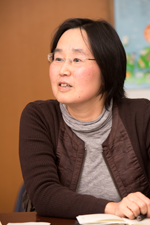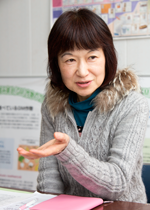Three Years since the Disaster Protecting Children
Three Years since the Disaster
Protecting Children in Fukushima

Three years have passed since “3-11” (the Great East Japan Earthquake). The Seikatsu Club Consumers' Cooperative Union (SCCCU) has asked its members for donations three times and has been working to support survivors of the disaster. Ms. Hiromi Otsuyama, Chairperson of the Board of Directors of the Seikatsu Club (SC) Fukushima talked with Ms. Mayumi Niizeki, who was one of the first people to urge the Fukushima prefectural government to disclose the results of thyroid gland checks conducted by the prefecture. They talked about the kind of measures needed to protect children from radiation. (Posted on March 4th)
Fukushima Government Reluctant to Disclose Information
 Otsuyama: In October 2011, the Fukushima government began to check children’s thyroid glands as part of the Fukushima Health Management Survey covering children who were between 0 and 18 years old at the time of the disaster. Your high school student daughter had her thyroid glands checked, didn’t she?
Otsuyama: In October 2011, the Fukushima government began to check children’s thyroid glands as part of the Fukushima Health Management Survey covering children who were between 0 and 18 years old at the time of the disaster. Your high school student daughter had her thyroid glands checked, didn’t she?
Niizeki: Yes, she had the test in November 2011 because we were living in an evacuated area. She was graded as “A2” which meant her thyroid glands had nodules smaller than 5.0 mm or cysts smaller than 20.0 mm. The result was just written on a piece of paper and it said “no apparent abnormalities”. I immediately made a telephone call to the Fukushima government because I did not understand what it meant and felt scared. I asked them to give us the photo of her thyroid, but they would not. They did not give us understandable explanations, either.
Otsuyama: That is why you resorted to a right-to-know request to the prefecture. But you had to take complicated steps for the request. We worked with civil society organizations to negotiate with the prefecture and they finally introduced a simplified process, but it was too late.
Niiseki: Although she is undoubtedly my own daughter I had to submit a copy of our family register. It usually takes two weeks to receive the information requested, but it actually took nearly a month. In addition, they told us that they would give us the photo, but it was printed on a sheet of regular paper. We felt that they were reluctant to give out information and try to hide reality. The government does not take malignant or malignancy-suspected cases into due consideration saying that “they are of little relevance to the nuclear accident.”
Otsuyama: They said it was because “the first case of thyroid cancer was found four years after the accident in the case of the Chernobyl nuclear power plant accident.” About 239,000 children took a preliminary test, and 59 out of the children who took a secondary test were suspected of malignancy. A central figure in Fukushima prefecture’s testing program initially said that “the number of thyroid cancer cases is usually one or two in one million people” but the reality is totally beyond comparison.
Niizeki: The prefecture introduced a system to certify thyroid gland test facilities only after having doctors go through a long series of training programs. That is why there are few doctors working on the testing and the government is negative about the test. There is still no facility certified by the government.
Otsuyama: SCCCU organized the “Thyroid Gland Check Activities” in 2012 to compare Fukushima with other areas, but the SC Fukushima could not participate in the activities for the same reason. The SC Fukushima will work with local health care facilities and doctors, and plans to conduct thyroid gland checks for 100 people in Fukushima City and Koriyama City.
Taking a Deep Breath
 Niizeki: Thyroid gland checks are designed to detect the influence of radioactive iodine, but we are still exposed to cesium. More blood and urine tests should be conducted to examine internal exposure. If not, the reality of radioactive effects remains unknown. Decontamination work reduces radioactive substances to some extent around a small area only. There are many places where decontamination work has not yet been carried out, so we hesitate to take a deep breath. I am confident about the safety of our food because I am a member of SC, but my mother mostly cooks food from Fukushima. I cannot help thinking that my children should not eat them.
Niizeki: Thyroid gland checks are designed to detect the influence of radioactive iodine, but we are still exposed to cesium. More blood and urine tests should be conducted to examine internal exposure. If not, the reality of radioactive effects remains unknown. Decontamination work reduces radioactive substances to some extent around a small area only. There are many places where decontamination work has not yet been carried out, so we hesitate to take a deep breath. I am confident about the safety of our food because I am a member of SC, but my mother mostly cooks food from Fukushima. I cannot help thinking that my children should not eat them.
Otsuyama: In March 2013, we sent a questionnaire to our members in Naka-dori, Fukushima (central Fukushima) and asked them about their attitude toward radiation. There were five questions such as “Do you care about radiation in your daily life?” and “Are you concerned about what you eat?” Most people answered “very much” or “a little” to the questions on radiation. The issue of radiation is not solved yet. There are a lot more things that need to be done for reconstruction. We still have a long way to go.
Niizeki: I participated in a refreshment tour* and took a deep breath for the first time in quite a while. Not only children who cannot play outside but also their mothers are enduring daily stress. Refreshment tours are important for mothers, too.
Osuyama: According to the questionnaire, many people hope that the refreshment tours will continue. In addition, members of SC who participated in the tours feel differently now and have begun to say “we should do something” instead of only participating in the tours.
(Excerpt from “Reconstruction Support News”, February 2014)
(*)Refreshment tours
The Seikatsu Clubs in different parts of Japan organize “Refreshment Tours for Children in Fukushima” so that they can play outside to their hearts content. Last summer, a total of 216 people participated in 16 tours (including a tour to Korea) to 12 Seikatsu Clubs from Hokkaido to Hyogo.
生活クラブをはじめませんか?
42万人が選ぶ安心食材の宅配生協です
ウェブ加入限定 無料プレゼント






